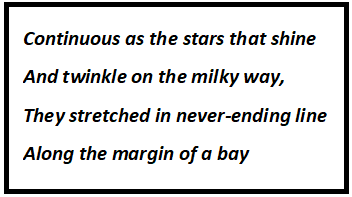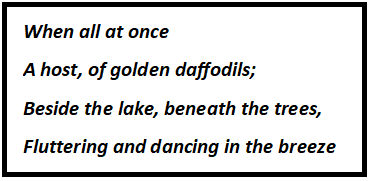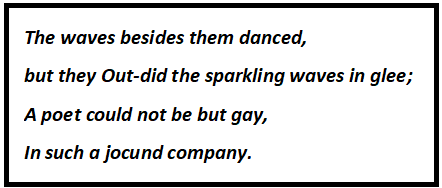Hi Everyone!! This article will share Daffodils Questions & Answers.
The poem is written by William Wordsworth and is inspired by the beautiful landscape around. The poet wrote this poem when he was living with her sister Dorothy in the Lake District. I have already shared Daffodils Stanza Wise Summary in my previous post so, make sure to check that post as well.
Daffodils Questions & Answers
Question 1: What was the poet doing?
Answer: The poet was wandering alone in the country side.
Question 2: While the poet was wandering, what did he see and where did he see them?
Answer: The poet saw a host of golden daffodils while he was wandering. He saw the daffodils growing beside the lake, beneath the trees.
Question 3: How many daffodils does the poet say that he saw at a glance? Why does he say so?
Answer: The poet says that he saw ten thousand daffodils at a glance. He says so in order to highlight that the whole area along the lake was covered with blooming, uncountable daffodils.
Question 4: Why does it appear that waves and the daffodils are competing?
Answer: When the poet saw the daffodils they appeared to be tossing their head in sprightly dance. The waves in the bay beside which the daffodils grew also appeared to be moving in a joyful dance. Moreover, the poet felt that the movement of the daffodils was better than that of the sparkling waves. Thus it appears as though the daffodils and the waves were competing.
Question 5: What does the first line of the poem tell you?
Answer: The first line tells us that the poet wanders lonely as a cloud.
Must Read: A Grain as Big as a Hen’s Egg Questions & Answers
Daffodils Questions & Answers
Question 6: What does the poet compare daffodils to? Why does he make such a comparison?
Answer: The poet compares the daffodils to the stars that shine and twinkle in the Milky Way. The poet makes such a comparison, because to him, the daffodils seemed to grow in never-ending lines like the stars in a galaxy. Also, the yellow daffodils seemed to shine and glow brightly like the stars twinkling in the sky.
Question 7: Read and answer the following questions:

(a) What does ‘They’ refer to?
Answer: ‘They’ refers to the daffodils.
(b) What does the poet compare them to?
Answer: The poet compares them to the galaxy of innumerable stars in the sky.
(c) Why does he do so?
Answer: The glowing daffodils, sparkling in the sunlight, were stretched along the bay. This appeared like twinkling stars in the sky, to the poet.
Question 8: Identify the figure of speech in the following lines:
(a) ‘I wandered lonely as a cloud’
Answer: Simile
(b) ‘Fluttering and dancing in the breeze’
Answer: Personification
(c) ‘Continuous as the stars that shine’
Answer: Alliteration
Question 9: What does ‘jocund company’ mean?
Answer: ‘Jocund Company’ means a cheerful company. The joyful company of daffodils was the ultimate source of pleasure for the poet and he can feel nothing but happiness in that company.
Question 10: Explain the lines: ‘Outdid the sparkling waves in glee…’
Answer: The poet says that there were waves which were dancing in the lake but were no match for the waves of daffodils rippling in the breeze. The joyful dance of daffodils was a way better than theirs.
Question 11: Describe the poet’s thoughts on seeing the daffodils.
Answer: The poet felt that one cannot be anything but happy in the company of the cheerful daffodils. The beautiful daffodils filled his heart with joy.
Question 12: What is the ‘wealth’ the poet gained?
Answer: The wealth that the poet gained from the daffodils was the wealth of happiness that fills his heart when he thinks of the daffodils.
Daffodils Questions & Answers
Question 13: How do we know that ‘this’ show of the daffodils had a long-lasting effect on the poet?
Answer: The poet gives us a vivid description of the daffodils and the place where he saw them. The poet also mentions that when he saw the daffodils he didn’t realize the wealth of experience he had accumulated. However, later on, when he sat in a thoughtful mood the image of the daffodils flashed in his mind. This tells us that the show of the daffodils has had a long-lasting effect on the poet.
Question 14: When does the poet remember the daffodils? How does he feel?
Answer: The poet often remembers the daffodils when he rests on his couch in a deep and pensive mood. The memory of the daffodils fills his heart with pleasure.
Question 15: Read the extract and answer the following questions:
“They flash upon…………………………………….the bliss of solitude.”
(a) Give the synonym of the word ‘bliss’.
Answer: pleasure/happiness
(b) What is referred to as ‘they’?
Answer: ‘They’ refers to the daffodils.
(c) When do they flash upon the poet’s inward eye?
Answer: The scene of the daffodils flash upon the poet’s inward eye when he lies on his couch in a pensive mood.
(d) Where did the poet see them?
Answer: The poet saw several daffodils fluttering in the breeze, under the trees, along the margin of a bay.
Question 16: Read and answer the following questions:

(a) How did the speaker feel when he saw the daffodils?
Answer: The speaker felt light-hearted and happy when he saw the daffodils.
(b) How do the phrases ‘beside the lake’ and ‘beneath the trees’ add to the effect?
Answer: The phrases ‘beside the lake’ and ‘beneath the trees’ convey what the speaker had observed. The reader understands that the speaker’s encounter with the daffodils was not imaginary, it happened in real life.
(c) How does the speaker convey the idea that there were lots of them?
Answer: The speaker conveys the idea that there were lots of them by using the words ‘crowd’ and ‘host’.
Daffodils Questions & Answers
Question 17: What impression does the word ‘wandered’ create? What if the speaker had used the word ‘walked’ instead? Would the effect have been the same?
Answer: The word ‘wandered’ conveys the delicate movement of a floating cloud. The speaker, much like the cloud is not guided by any sense of direction. The word ‘walked’ would not convey the same image as ‘wandered’. The word ‘wandered’ creates the impression of a carefree soul. ‘Wandered’ sounds more poetic than ‘walked’.
Question 18: Read and answer the following questions:

(a) Why does the poet say that the waves were dancing?
Answer: The sparkling waves reflecting the bright sunlight kept moving back and forth in the wind and appeared to be dancing, to the poet.
(b) What does the poet mean by ‘out-did the sparkling waves in glee’?
Answer: Though the waves gushed beautifully in the strong winds, they stood no comparison to the beauty of the sprightly tossing of the flowers that were stretched along the sides of the river.
(c) What effect did all this have on the poet?
Answer: The poet felt extremely happy and delighted in the cheerful company of the flowers.
Question 19: Describe the lasting impression of the daffodils on the poet.
Answer: The poet was captivated by the beauty of the daffodils which he saw near the trees and by the side of the river. The daffodils tossing their heads as if dancing to the tune of the breeze, and sparkling like the stars in the galaxy, in their vibrant golden colour, gave him great pleasure at that moment. But little did the poet realise that the delightful experience would never vanish from his mind, as whenever the poet was lonely or in a sad mood, the very flash of the golden daffodils in his mind made him happy again.
Question 20: How does the mood of the poet change in the poem Daffodils?
Answer: In the beginning, the poet describes himself as a lonely cloud that floats over the hills and valleys, thus creating a melancholic feeling. This feeling soon gives way to one of joy in the presence of rows of daffodils. The poet, who is a lover of nature, is transmitted from a world of loneliness to one of long-lasting happiness at the sight of these golden-yellow flowers that provide much comfort to his lonely heart.
Question 21: How does the poem make use of contrast in the poem Daffodils?
Answer: The poet was all alone and wandered aimlessly while the bright and lively daffodils stretched along the bay and were close together. He appeared to be in a melancholy mood. In contrast, the daffodils fluttered and danced, tossing their heads displaying exuberance in their movement.
So, these were Daffodils Questions & Answers.